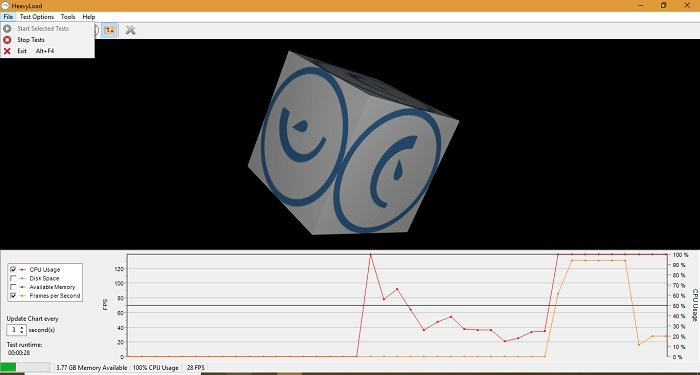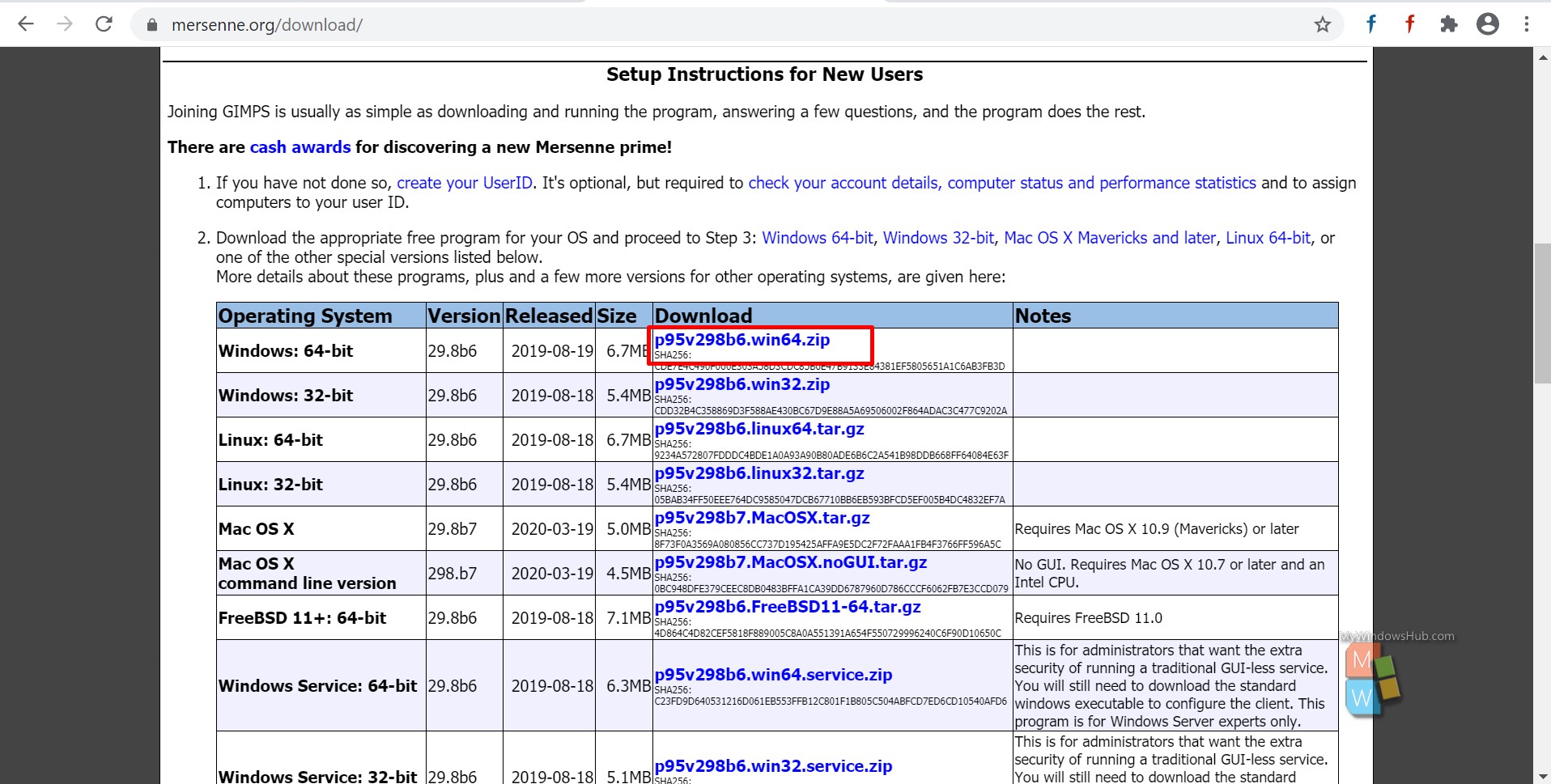When using EKG and blood pressure monitoring alone the test is variously called a cardiac stress test, exercise stress test, exercise treadmill test, exercise tolerance test, stress test or exercise ECG test. Heart rate, breathing, blood pressure, EKG, and how tired you feel are monitored during the test. What is CPUTest for Mac. CPUTest is a GUI for the selftest command of Glucas. This command can be used to stress test a CPU and its cooling system. CPUTest may be used to verify stability when undervolting and overclocking CPUs. A universal binary executable of Glucas is included. Documentation is included in the download.
Latest version: 30.3 build 6 - see the latest WhatsNew.txt file for a full list of changes. Recent changes include:- PRP with proofs. Eliminates the need for lengthy double-checking!!!
- Resource Limits dialog box to control Prime95's resource usage. See the readme.txt file for setting these options
Highlights of version 29.8 include
- AVX-512 support
- Modified torture test dialog box with new options and better understanding of the L1/L2/L3 cache hierarchy
- More robust implementation of Gerbicz error checking in PRP tests. This replaces LL testing as the default work type
Highlights of version 29.4 include
- GIMPS has a new sub-project -- finding (probable) prime Mersenne cofactors
- Like LL tests, PRP tests now support shift counts to aid in running double-checks
- PRP tests now support a type of low overhead error checking that almost guarantees correct results even on flaky hardware
- Because PRP tests are highly reliable, we now offer the option to do PRP tests instead of Lucas-Lehmer primality tests
- For non-base-2 PRP tests, there is a new option to run each iteration twice and rollback if a mismatch occurs
Highlights of version 29.3 include
- Enhanced error checking for LL tests
- Faster step 1 GCD for ECM and P-1 factoring
Highlights of version 29.2 include
- New benchmarking routines to determine the optimal FFT code
- Changes to default CPU cores assigned to each worker to optimize total throughput per system
- Optimized FFT sizes for AMD Ryzen
- The new code will now do multithreaded trial factoring
- Faster factoring code using FMA if available
- Improvements to the hyperthread core detection
“CPU Stress Test Online” or simply “CPU Load Test” is a free processor performance test allowing you to check online your processor at heavy load. Unlike the “CPU Benchmark Online”, here you can manually set the required load, as well as stop or resume testing at any time. However, your results will not be stored in the “CPUs Rank”, and you will not be able to compare your processor to the other ones. On the other hand, here you can find out the limits of your processor’s performance.
Mac Stress Test Software Free

Power
What do the indicators mean?
Before starting the CPU stress test, review the indicators below to understand what they are for. Given that not all processors and devices withstand high loads, it is strongly recommended to gradually increase indicator values.
- Speed
The speed measures how fast the processor is, and is measured in the number of hash operations per second. Obviously, a more powerful processor develops a higher speed. However, you need to remember that for maximum speed you need to use the full power of the CPU (that is, specify as many threads and power as possible). - Threads
The number of threads determines the number of simultaneous operations for computing hashes. Thus, more threads lead to a higher speed, but at the same time to a higher load. Multi-core CPUs cope better with the multithreading, this is why in such cases modern processors work faster and get better results. - Power
The power indicates how much CPU time can be used by one thread (for example, 100% power means full speed without time idle). Since the power and the number of threads almost proportionally affect the speed, a 100% power + 1 thread will give the same speed as 50% power + 2 threads, or 25% power + 4 threads. Thus, more power and threads will provide higher speed and CPU load (for example, 50% power + 10 threads will result in a 500% load). - Points
The number of score points indicates how many hashes were computed during the test. As you might have guessed, the number of points directly depends on the speed and the test duration. - FPS
The number of frames per second (abbreviated as FPS) indicates how fast your browser is able to render new frames. As a rule, in most cases, browsers render frames at a speed of 60 FPS (although sometimes a slightly lower speed may be acceptable). However, if the frame rate drops below 30 FPS, it means that something is wrong (for example, the system cannot keep up with the current workload). Thus, FPS is a good indicator while running a CPU stability test.
How to run a CPU stability test?
The purpose of a processor stability test is to determine how smoothly the CPU works, even if it is under high load. So, to run a CPU stability test you have to:
- Start the CPU Stress Test at maximum load and wait 30-60 seconds.
- Keeping this tab in the background (don’t close it), switch to other applications or tabs, and do what you do as usual.
- Make sure everything runs smoothly and this “stressful situation” does not affect your usual tasks.
- Monitor the “Speed” and “FPS” indicator and make sure that their values do not drop significantly.

How to test the CPU at maximum load?
If you want to feel the smell of a heated device and hear the sound of the roaring fan, don’t hesitate to burn stress your CPU at heavy load as follows:
- Enter the maximum number of “Threads”: 128.
- Set the full “Power”: 100%.
- Press the “Start CPU Stress Test” button.
- Stay tuned for global warming news.

Why did my system become unstable during testing?
At maximum load, the stress test will try to use the full capacity of your CPU, which in the long term can lead to the fact that other processes will be performed more slowly and slowly, and some will even hang. For this reason, the stability of the system or other applications may be affected during testing. As a rule, modern systems and processors perfectly handle this and you should not experience big performance issues. Given this, you can consider it as a CPU stability test, which will show how well your system is coping with heavy loads. If you are planning to knockout your system by torturing all hardware, consider to use a PC Stress Test.
Why did my device shut down during the stress test?
Most likely your device shuts down to protect its hardware from overheating, which can definitely damage it if the temperature is not dropped or/and device is not de-energized immediately. This is why your device shuts down suddenly without any warning and it reports the reason for shutdown the next time it is turned on (although sometimes devices are silent about it).
This is a common and required behavior, so you should not worry about the fact that your device has turned off. However, you should be worried if your device heats up and shuts down too fast. Most often this happens if cooling system does not work properly (for example, lack of sufficient air flow or faulty heat dissipation). Another common reason might be that your device is not designed for heavy loads or its hardware is misconfigured. Either way, you must find out the cause and fix it before running more stress tests.
What is the difference between a PC Stress Test and CPU Stress Test?
They both are trying to knockout your system, except a CPU Stress Test tortures only the processor, while a PC Stress Test has a richer arsenal to test not only the CPU, but also GPU, RAM, HDD, and other hardware.
Best Gpu Stress Tests
What is the best CPU stress test?
First of all, like any software, the best CPU stress testing tool must meet your system requirements. Next, it should be able to really torture your CPU. Finally, useful, but not necessary it should allow you to monitor system performance, measure temperature, create reports, run benchmarks, and provide features that you need.
If someone refers to the CPUX.Net Stress Tool as the best CPU Stress Test, I certainly won’t argue with that, especially if we’re talking about online testing tools 😉 However, if you are planning overclock your CPU, perhaps you may want a better stability tester written in a low-level programming language and it is able to torture all hardware at maximum. That’s why I recommend you to take a look at Prime95, Furmark CPU Burner, MSI Kombustor, Cinebench, CPU-Z, AIDA64, Intel Extreme Tuning Utility (Intel XTU), OCCT Linpack.
What are the system requirements to run the online CPU Stress Test?
Since this is web based CPU stress test, by and large you can run it almost anywhere, such as:
- Browsers (Chrome, Firefox, Edge, Safari, Internet Explorer).
- Devices (laptop, desktop, smartphone, tablet).
- Operating systems (Windows, Linux, macOS, Android, iOS).
- CPU Manufacturers (AMD, ARM, Huawei, Intel, Mediatek, Nvidia, Qualcomm, Samsung).